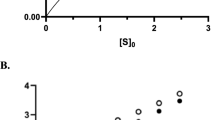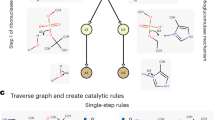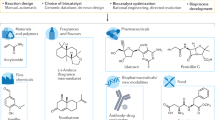Abstract
WE were searching for a model of an enzymatic reaction in the hope that the relatively simple chemistry of the model reaction might throw some light on the enzyme reaction itself. In particular, we were interested in finding a model which would duplicate some of the properties of lipases, notably their ability to catalyse the hydrolysis of lipids and the characteristic pH dependence of lipolytic activity which reaches a maximum near pH 8.5 with most lipases, and one just below pH 7 with some. Lipases being proteins, the model would have to be restricted to the functional groups available in proteins. The high potency of lipases, despite this restriction, together with the well-known chemical mechanism of ester hydrolysis, made us suspect that bifunctional catalysis1 might play a decisive part.
This is a preview of subscription content, access via your institution
Access options
Subscribe to this journal
Receive 51 print issues and online access
$199.00 per year
only $3.90 per issue
Buy this article
- Purchase on Springer Link
- Instant access to full article PDF
Prices may be subject to local taxes which are calculated during checkout
Similar content being viewed by others
References
Swain, C. G., et al., J. Amer. Chem. Soc., 70, 1119 (1948); 74, 2534, 2538 (1952).
Gero, A., J. Org. Chem., 16, 1222 (1951); Science, 119, 112 (1954).
Alper, C., in Reiner, M., “Standard Methods of Clinical Chemistry”, 1, 71 (Academic Press, New York, 1953).
Author information
Authors and Affiliations
Rights and permissions
About this article
Cite this article
GERO, A., WITHROW, C. Chemical Model of a Biological Reaction. Nature 180, 1354–1355 (1957). https://doi.org/10.1038/1801354a0
Issue Date:
DOI: https://doi.org/10.1038/1801354a0
This article is cited by
Comments
By submitting a comment you agree to abide by our Terms and Community Guidelines. If you find something abusive or that does not comply with our terms or guidelines please flag it as inappropriate.



